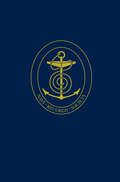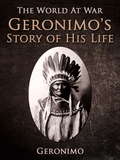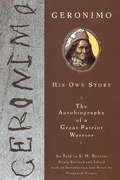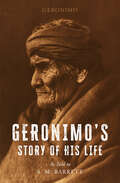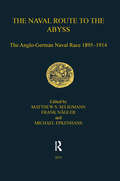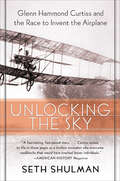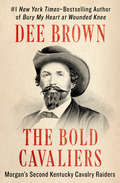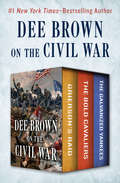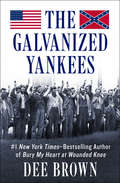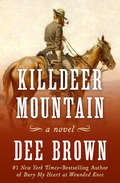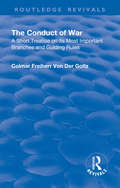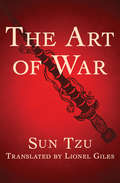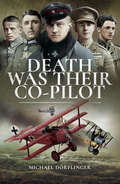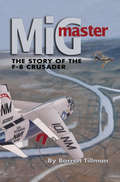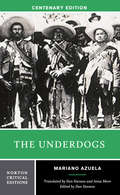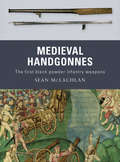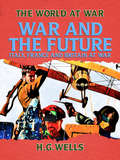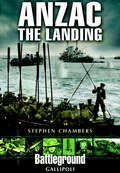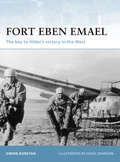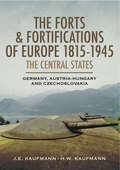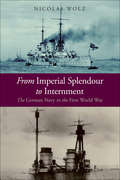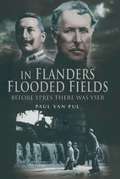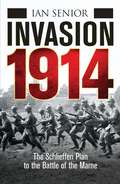- Table View
- List View
A Descriptive Catalogue of the Naval Manuscripts in the Pepysian Library: Vol. I
by J.R. TannerSamuel Pepys (1633-1703) made a significant contribution to British history by his work as a naval administrator, and he bequeathed to Magdalen College, Cambridge its greatest treasure – his library, a unique collection of 3,000 books and manuscripts, still preserved as he left it. There are 250 volumes of manuscripts and these NRS volumes published selected documents from the collection.In this volume Tanner gives a lengthy general introduction to Pepys’s career as a naval administrator and to the papers he left at his death, and also prints from them lists of ships and officers from 1660 to 1688.
Geronimo's Story of His Life (The World At War)
by GeronimoGeronimo's Story of His Life is the oral life history of a legendary Apache warrior. Composed in 1905, while Geronimo was being held as a U.S. prisoner of war at Fort Sill, Oklahoma.
Geronimo
by GeronimoEnter the world of Geronimo Stilton, where another funny adventure is always right around the corner. Each book is a fast-paced adventure with lively art and a unique format kids 7-10 will love. Ah, there's nothing like a relaxing vacation on the beach! I would spread out by the crystal-clear water with a good book. What more could a mouse want? At least, that was the plan. But somehow, my vacations never seem to go according to plan. Instead of a beautiful seaside resort, I found myself in a fleabag hotel that was falling down around my ears! Oh, would I ever be able to relax and enjoy my vacation??
Geronimo's Story of His Life: As Told to S. M. Barrett
by Geronimo S. M. BarrettA pivotal piece of nineteenth-century Native American history from a tireless warrior seeking justice for his people. Storied leader of the Bedonkohe band of the Chiricahua Apache tribe, Geronimo led resistance against Mexican and American troops seeking to drive the Apache from their land during the 1850s through the 1880s. In 1886, he finally surrendered to the US Army and became a prisoner of war. Although he would never return to his homeland, Geronimo became an iconic figure in Native American society and even had the honor of riding with President Theodore Roosevelt in his 1905 inaugural parade. That same year, he agreed to share his story with Stephen M. Barrett, a superintendent of education from Lawton, Oklahoma. In Geronimo&’s own words, this is his fascinating life story. Beginning with an Apache creation myth, he discusses his youth and family, the bloody conflicts between Mexico and the United States, and his two decades of life as a prisoner. Revered by his people and feared by his enemies, Geronimo narrates his memoir with a compassionate and compelling voice that still resonates today.
The Naval Route to the Abyss: The Anglo-German Naval Race 1895-1914 (Navy Records Society Publications)
by Matthew S. Seligmann Frank NäglerThe intense rivalry in battleship building that took place between Britain and Germany in the run up to the First World War is seen by many as the most totemic of all armaments races. Blamed by numerous commentators during the inter-war years as a major cause of the Great War, it has become emblematic of all that is wrong with international competitions in military strength. Yet, despite this notoriety, ’the Great Naval Race’ has not received the attention that this elevated status would merit and it has never been examined from the viewpoint of both of its participants simultaneously and equally. This volume, which contains a comprehensive survey of the existing scholarship on this topic, both English-language and German, as well as important primary source materials from a range of archives in both Britain and Germany, fills this gap. By putting the actions of the British Admiralty side-by-side with those of its German counterparts, it enables the naval race to be viewed comparatively and thereby facilitates an understanding of how the two parties to this conflict interacted. By offering a comprehensive range of German documents in both their original text and in English translation, the book makes the German role in this conflict accessible to an English speaking audience for the first time. As such, it is an essential volume for any serious student of naval policy in the pre-First World War era.
Unlocking The Sky: Glenn Hammond Curtiss and the Race to Invent the Airplane
by Seth Shulman“[A] compelling revision of aviation history.” — Houston Chronicle“Shulman tells a fascinating, fast-paced story and does an admirable job of balancing the historical scales. ” — American History“Great storytelling and a knack for rekindling all-but-forgotten historic scenes.” — Boston Globe“An enlightening exploration of the dissonance of history and mythology.” — New York Times Book Review“Shulman has written a captivating story … of aviation’s earliest days.” — St. Paul Star-Tribune
The Bold Cavaliers: Morgan's Second Kentucky Cavalry Raiders
by Dee BrownA thrilling Civil War history of Morgan's Raiders, the Confederate cavalrymen who spread terror through the NorthIn this vibrant and thoroughly researched Civil War study, Dee Brown tells the story of Morgan's Raiders, the Kentucky cavalrymen famed and feared for their attacks on the North. In 1861, Brigadier General John Hunt Morgan and his brother-in-law Basil Duke put together a group of formidable horsemen, and set to violent work. They began in their home state, staging raids, recruiting new soldiers, and intercepting Union telegraphs. Most were imprisoned after unsuccessful incursions into Ohio and Indiana years later, but some Raiders would escape, regroup, and fight again in different conflicts, participating in the so-called Great Conspiracy in Canada. The Bold Cavaliers is as engrossing in its historical detail as in its rich adventure. This ebook features an illustrated biography of Dee Brown including rare photos from the author's personal collection.
Dee Brown on the Civil War: Grierson's Raid, The Bold Cavaliers, and The Galvanized Yankees
by Dee BrownThree true tales of Civil War combat, as recounted by a #1 New York Times–bestselling author of Bury My Heart at Wounded Knee. The acclaimed historian of the American West turns his attention to the country’s bloody civil conflict, chronicling the exploits of extraordinary soldiers who served in unexpected ways at a pivotal moment in the nation’s history. Grierson’s Raid: The definitive work on one of the most astonishing missions of the Civil War’s early days. For two weeks in the spring of 1862, Col. Benjamin Grierson, a former music teacher, led 1,700 Union cavalry troops on a raid from Tennessee to Louisiana. The improbably successful mission diverted Confederate attention from Grant’s crossing of the Mississippi and set the stage for the Siege of Vicksburg. General Sherman called it “the most brilliant expedition of the war.” The Bold Cavaliers: In 1861, Brig. Gen. John Hunt Morgan and his brother-in-law Basil Duke put together a group of formidable horsemen, and set to violent work. Morgan’s Raiders began in their home state, staging attacks, recruiting new soldiers, and intercepting Union telegraphs. Most were imprisoned after unsuccessful incursions into Ohio and Indiana years later, but some Raiders would escape, regroup, and fight again in different conflicts. “Accurate and frequently exciting” (Kirkus Reviews). The Galvanized Yankees: The little-known and awe-inspiring true story of a group of captured Confederate soldiers who chose to serve in the Union Army rather than endure the grim conditions of prisoner of war camps. “An accurate, interesting, and sometimes thrilling account of an unusual group of men who rendered a valuable service to the nation in a time of great need” (The New York Times Book Review).
The Galvanized Yankees: Grierson's Raid, The Bold Cavaliers, And The Galvanized Yankees
by Dee BrownThe awe-inspiring true story of a group of Confederate soldiers who served in the Union ArmyHistorian Dee Brown uncovers an exciting episode in American history: During the Civil War, a group of Confederate soldiers opted to assist the Union Army rather than endure the grim conditions of POW camps. Regiments containing former Confederates were not trusted to go into battle against their former comrades, and instead were sent to the West as "outpost guardians," where they performed frontier duties, including escorting supply trains, rebuilding telegraph lines, and quelling uprisings from regional American Indian tribes, which were sweeping across the Plains. This is an account of an extraordinary, though often overlooked, group of men who served in unexpected ways at a pivotal moment in the nation's history. This ebook features an illustrated biography of Dee Brown including rare photos from the author's personal collection.
Killdeer Mountain: A Novel
by Dee BrownAn intrepid reporter's investigation into the death of a controversial major reveals a surprising story of betrayal and redemptionIt is 1866, and Sam Morrison, reporter for the St. Louis Herald, is aboard a steamer bound for Fort Standish off the coast of Massachusetts, determined to solve a mystery. The fort is about to be renamed in honor of Charles Rawley, a major who recently died in a fire while trying to prevent the escape of a captured Sioux chief. But just who was Rawley? Morrison is told a dizzying host of tales about the man--some call him a despot but others describe him as a martyr. He was a man all too willing to execute a deserter, but one who would spur his troops to do the utmost to ensure the safety of women and children. As the investigation unfolds, Morrison doesn't know which stories to believe--especially when it comes to the truth about Rawley's death. Thrilling and wily, Killdeer Mountain is a deft triumph of historical fiction. This ebook features an illustrated biography of Dee Brown including rare photos from the author's personal collection.
Revival: A Short Treatise on its Most Importsant Branches and Guiding Rules (Routledge Revivals)
by Colmar Freiherr von de GoltzThis book contains, in a brief form, author’s views a to the conduct of the principal strategical and tactical operations of war, and will be found to be a short and convenient introduction to a deeper study of the rules which should underlie the direction of the ever-varying incidents of modern fighting.
Tragedy at Honda
by Charles LockwoodKnown to seafarers as the Devil's Jaw, Point Honda has lured ships to its dangerous rocks on the coast of California for centuries, but its worst disaster occurred on 8 September 1923. That night nine U.S. Navy destroyers ran into Honda's fog-wrapped reefs. Part of Destroyer Squadron 11, the ships were making a fast run from San Francisco to their homeport of San Diego at a steady 20 knots as fog closed around them. The captain of the flagship Delphy ordered a change of course, but due to navigational errors and unusual currents caused by an earthquake in Japan the previous week, she ran aground and eight destroyers followed her. The authors recreate in dramatic hour-by-hour detail what happened, including the heroic efforts to rescue men and ships. In addition to presenting a full picture of the tragedy, they cover the subsequent investigations, which became a media sensation. In conclusion, the authors suggest that the cause of the tragedy lay in the interpretation of the differences that exist between the classic concepts of naval regulations and the stark realism of the unwritten code of destroyer doctrine to follow the leader. Admiral Nimitz's introduction sets the scene for this action-filled account of America's greatest peacetime naval tragedy in history. Only Pearl Harbor in 1941 would do more damage.
The Art of War: The Essential Translation Of The Classic Book Of Life (Penguin Modern Classics Series #909)
by Sun TzuThe world&’s most influential treatise on strategy Mao Zedong used it to defeat Chiang Kai-shek. Colin Powell thinks every US soldier should be familiar with its principles. New England Patriots coach Bill Belichick built a football dynasty out of lessons learned within its pages. Even Gordon Gekko and Tony Soprano are fans. In the twenty-five hundred years since it was composed, The Art of War has been applied to just about every field of human endeavor. Sun Tzu&’s shrewd advice is indispensible to anyone seeking to gain an advantage over an opponent.
Death Was Their Co-Pilot: Aces of the Skies
by Michael DorflingerIt was in World War I that the skies first became a battlefield, with nations seeking to decide military outcomes off the ground. This volume introduces the fighter pilots of World War I, including the infamous Red Baron Manfred von Richthofen. In addition to this iconic flying ace, the author presents the thrilling biographies of numerous others and recounts their exploits and the tragedies they suffered. Likewise, the book illustrates the Great Wars historical background and documents the increasing sophistication of aviation technology and warfare.
MiG Master
by Barrett TillmanTo be equally enjoyed by professional aviators and aviation buffs with limited technical knowledge, this biography brings to life the legendary aircraft that scored the highest kill ratio of any U.S. fighter aircraft in the Vietnam War. The book is filled with authentic re-creations of Crusader-MiG fights and vivid descriptions of the people and events that are part of the F-8 story, including John Glenn's 1957 record-breaking flight across the United States in three hours and twenty-three minutes. As the Navy's first supersonic aircraft, the Crusader holds an honored spot in carrier flying, and the author shows why it is called one of the most capable, versatile, and long-lived aircraft in naval aviation history. Barrett Tillman effectively combines an exciting account of the F-8's operational history with a detailed and authoritative explanation of its design, construction, and modifications. Tillman recalls the years of frustration and experimentation spent in refining the aircraft and its gunnery system, and then takes the reader through key actions in Vietnam where seasoned pilots handled their "rambunctious steeds" with scarcely a glance in the cockpit. Extensive appendixes provide further details.
The Underdogs
by Mariano AzuelaLos de abajo (The Underdogs) is Mariano Azuela's unforgettable novel of the Mexican Revolution (1910-17). It is widely regarded as the best Mexican novel about the war and was published during the armed struggle. This Norton Critical Edition is based on a new translation by acclaimed scholars Ilan Stavans and Anna More. It is accompanied by Stavans' introduction and explanatory footnotes. Numerous artists and intellectuals have commented on The Underdogs, and the Norton Critical Edition includes a judicious selection of these comments to help place the novel in its historical context. The eyewitness account of John Reed is joined by the assessments of Anita Brenner and Octavio Paz. A 1994 letter by Subcomandante Marcos to Mexico's then-president Ernesto Zedillo points to the Mexican Revolution as an unfinished event, one that brought little relief to large segments of the country's population. Five wide-ranging critical assessments of Mariano Azuela and The Underdogs are provided by Waldo Frank, Harriet de On#65533;s, Luis Leal, Ilan Stavans, and Clive Griffin. A selected bibliography is also included.
Medieval Handgonnes
by Gerry Embleton Sean MclachlanOsprey's new Weapon series provides a highly-detailed yet affordable overview of the development, use, and impact of small arms throughout history--from the sword to the machine gun. Journey back to the time when handguns had no moving parts! Variously called handgonnes, hackbuts, coulevrines, pistolas, schiopettos, tyufyaks, and even bombardelles, the first black powder infantry weapons were extremely crude by today's standards. In his new book, Sean McLachlan, author of American Civil War Guerilla Tactics, dispels the myth that these weapons were ineffective on the battlefield (beyond their terrifying noise!). Rather, he demonstrates through careful examination of the historical records that the handgonne was a viable weapon from its inception, even as it saw action side-by-side with the cross-bow.Readers will be treated to a lush collection of rare photographs and artwork from such far-flung locales as Danish National Museum and the Bayerisches Armeemuseum. Original artwork from Gerry and Sam Embleton illustrate how these weapons were used on the battlefield and reenactor photos demonstrate step-by-step how they were loaded and fired.
War and the Future: Italy, France And Britain At War (The World At War)
by H. G. WellsExcerpt: "One of the minor peculiarities of this unprecedented war is the Tour of the Front. After some months of suppressed information—in which even the war correspondent was discouraged to the point of elimination—it was discovered on both sides that this was a struggle in which Opinion was playing a larger and more important part than it had ever done before. This wild spreading weed was perhaps of decisive importance; the Germans at any rate were attempting to make it a cultivated flower. There was Opinion flowering away at home, feeding rankly on rumour; Opinion in neutral countries; Opinion getting into great tangles of misunderstanding and incorrect valuation between the Allies. The confidence and courage of the enemy; the amiability and assistance of the neutral; the zeal, sacrifice, and serenity of the home population; all were affected. The German cultivation of opinion began long before the war; it is still the most systematic and, because of the psychological ineptitude of the Germans, it is probably the clumsiest. The French Maison de la Presse is certainly the best organisation in existence for making things clear, counteracting hostile suggestion, the British official organisations are comparatively ineffective; but what is lacking officially is very largely made up for by the good will and generous efforts of the English and American press. An interesting monograph might be written upon these various attempts of the belligerents to get themselves and their proceedings explained."
Anzac–The Landing: Gallipoli (Battleground Gallipoli)
by Stephen ChambersThe Anzac legend was born on the shores of Gallipoli during the historic morning of 25th April 1915. Landing on a hostile beach, under the cover of darkness, the Anzacs moved inland rapidly, but the response of the Ottoman forces was equally quick. The outcome of the campaign was arguably sealed during the first day, when the door for an Anzac victory was closed. With the order to dig, dig, dig and to stick it out, a stalemate was secured from the clutches of almost total disaster. After the Australians and New Zealanders received their baptism of fire, they became a stubborn thorn in the sides of the Ottoman army. Futilely after eight grueling months of fighting, the campaign came to an end with the complete evacuation of the Gallipoli Peninsula.Failure did not mar the actions and sacrifice of the Anzacs who bestowed a powerful legacy, as well as being a landmark in the birth of modern Turkey. Almost a century later, with all the veterans now sadly gone, their legacy still survives in Anzac Day and with the ever increasing numbers of pilgrims who visit the battlefield today.This attractive and well-written book will serve as either a handy guide or concise history (or both).
Fort Eben Emael
by Simon Dunstan Hugh JohnsonAt the outbreak of World War II, Fort Eben Emael in Belgium was the strongest fortress in the world, and it lay exactly across the German invasion route of Belgium and France. The fort's elimination was essential for the success of Hitler's invasion of the West. Deemed impregnable to conventional attack, Hitler himself suggested the means for its capture with the first glider-borne assault in military history. On 10 May 1940, ten gliders carrying just 77 paratroopers landed on top of the fort. Using top-secret hollow-charge weapons for the first time in warfare, the assault pioneers of Sturmgruppe Granit subdued Fort Eben Emael within just 30 minutes, and the fortress surrendered within 30 hours. It remains one of the greatest raids in the annals of Special Forces.
The Forts & Fortifications of Europe 1815-1945: Germany, Austria-Hungry and Czechoslovakia
by J. E. Kaufmann H. W. Kaufmann&“Extremely well written and presented and gives you every scrap of information you&’ll ever need on cupolas, embrasures and cloches.&”—War History Online After the Napoleonic Wars, the borders of Central Europe were redrawn and relative peace endured across the region, but the volatile politics of the late nineteenth century generated an atmosphere of fear and distrust, and it gave rise to a new era of fortress building, and this is the subject of this highly illustrated new study. The authors describe how defensive lines and structures on a massive scale were constructed along national frontiers to deter aggression. The Germans, Austro-Hungarians and Czechs all embarked on ambitious building programs. Artillery positions, barbed-wire networks, casemates, concrete bunkers, trench lines, observation posts all sprang up in a vain attempt to keep the peace and to delay the invader. The strategic thinking that gave rise to these defensive schemes is described in detail in this study, as is the planning, design and construction of the lines themselves. Their operational history in wartime, in particular during the Second World War, is a key element of the account. &“A useful introduction for those wishing to develop a knowledge of fortifications and their impact on the conduct of war.&”—Firetrench &“The maps and plans, especially the plans, are numerous and extremely helpful. They show the arrangement of fortifications in a way that simple text would have found impossible. For those with an interest in European land fortifications of the 19th and 20th centuries, this book is an excellent general survey.&”—The Coast Defense Journal
From Imperial Splendour to Internment: The German Navy in the First World War
by Nicolas WolzThis important new work describes how the Imperial German Navy, which had expanded to become one of the great maritime forces in the world, second only to the Royal Navy, proved, with the exception of its submarines, to be largely ineffective throughout the years of conflict.The impact of this impotence had a far-reaching effect upon the service. Germany, indeed most of Europe, was in the grips of a spirit of militant nationalistic fervour, and the inactivity of the great Imperial Navy caused deep frustration, particularly among the naval officers. Not only were they unable to see themselves as heroes, they were also ridiculed on the home front and felt profoundly humiliated. With the exception of the one sea battle at Jutland, their ships saw little or no action at sea and morale slowly collapsed to a point where, at the end of the war, the crews were in a state of mutiny. The seemingly ludicrous order that forced the fleet to go to sea against the British in 1918 was driven by a sense of humiliation, but coming at the war's end it triggered a revolution because the German sailors wanted no part in such madness. The internment at Scapa Flow was the ultimate shaming. This is a fascinating and perceptive analysis of a whole era, and it contributes substantially to our understanding of the war and its consequences consequences, sadly, that helped pave the way for the Third Reich.
A History of the World in 100 Weapons
by Chris McnabIt's a truism to say that history is written by the winners. But what is it about the winners that make them so powerful? In this enlightening new book, Chris McNab searches for answers to this question and much more, telling the story of the history of the world through the lens of the weapons used over time.Arranged by age, McNab details 100 weapons of history in a highly-illustrated format. Among these 100 weapons: * Roman gladius that helped establish the Roman Empire * Japanese Katana, or Samurai sword * English longbow, used to defeat the French at the battle of Agincourt * Maxim gun * Flying Fortress of World War II - the epitome of US military superiority * bomb on Hiroshima that made a weapon the ultimate deterrent * AK-47 rifle.A History of the World in 100 Weapons presents each weapon in full detail, exploring the how and why of the weapon's development, the times from which it emerged, how it was used in battle and by whom, and to what extent and impact. details of how and why each weapon was invented, the times they emerged from, how they were used in battle.Drawing on stories of famous battles, wars and leaders associated with each weapon, McNab presents a vivid history of the weapons themselves and their context in the development of world history.
In Flanders Flooded Fields: Before Ypres There Was Yser
by Paul Van PulIn October 1914 four armies were converging on Dunkirk. While France was preparing to defend its main Channel port, the Germans were determined to take it while the British were busy using it. Caught in the middle was the Belgian Army. Belgium was almost totally overrun, safe for a small strip of land near the Pas-de-Calais.This is the story of what happened between Antwerp and Dunkirk that fateful month and how the King of the Belgians safeguarded the independence of his small nation from its all-powerful neighbours.Contains 25 custom-made maps, several drawings and 138 seldom seen photographs.
Invasion 1914
by Ian SeniorFor a century, accounts of the German invasion of France and the opening year of the First World War have been dominated by histories of British troops and their experience in battle, despite the fact that the British Expeditionary Force comprised just four divisions, while the French and Germans fielded 60 each. Published to coincide with the 100th anniversary of the outbreak of the Great War, Invasion 1914 examines how the German invasion of France and Belgium came agonizingly close to defeating the French armies, capturing Paris and ending the First World War before the end of the year. Ian Senior reveals how the initial German strategy revolved around, and in part depended on, rapid victory over the French, and how the failure to achieve this resulted in the surprisingly fluid battles of the early days of the war deteriorating into the trench-based warfare which was to see the war drag on for another four years of unprecedented slaughter. Weaving together strategic analysis, diary entries, eyewitness accounts and interview transcripts from soldiers on the ground with consummate skill, this narrative is a timely investigation into the dramatic early months of the war, as the fate of Europe hung in the balance.
